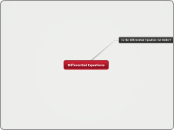arabera Matthew Dixon 13 years ago
768
Differential Equations

arabera Matthew Dixon 13 years ago
768

Honelako gehiago
1st Order: the right side of the equation = 0
Take the Laplace and put in terms of L{f(t)}
Refer to the back page of the book and match it to one of the premade equations in order to switch back to the f(t) domain
Solve using Eigenvectors
Please click on the globe to the right
No
Is it seperable
Seperable: where you can separate the variables to opposite sides of the equal sign and integrate
Can it be written in the form y'+p(t)=f(t)
no
Approximate using Euler's method
yes
Solve by the integrating factor method
I.Put into the form:
y'+P(x)y=Q(x)
II.The integrating factor will be e^(integral(P(x)dx, no +C neccessary
II.Multiply both sides by the integrating factor and integrate both sides
The left side will become (Integrating factor)*(y)
III.Solve for y
Solve by seperation of variables
I.Put all of one variable ie y,dy on one side and all of the other variables ie x, dx on the other
II.Integrate
Integrate